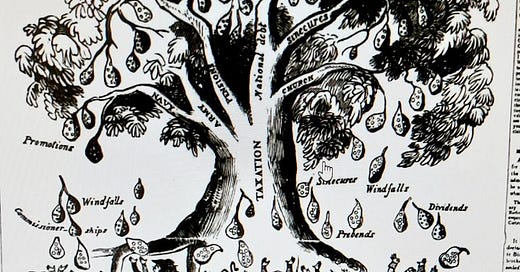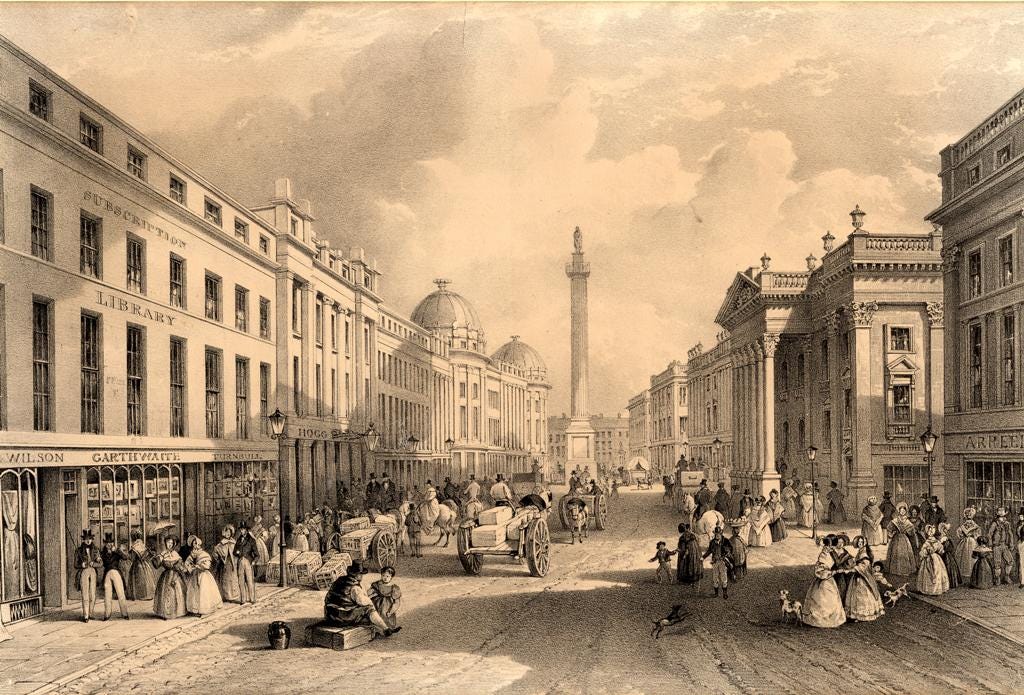Another extract from 1839: The Chartist Insurrection by David Black and Chris Ford, (with an introduction by John McDonnell M.P.). First published in paperback by Unkant Books in 2012, it has now been re-issued as an Ebook by BPC Publishing. Available from Amazon.
The coach left London at eight o’clock on the evening of 23 December 1838. George Julian Harney recalled, forty years later, that he travelled on the top deck with no protection from the elements, save the overcoat he was wearing and the leather apron on the seat buckled across his knees. There were twelve hours of darkness ahead before the first stop, and soon Harney began to feel as if his legs were ‘encased in ice’. After stopping at Grantham for breakfast the coach, lashed with rain and snow, passed through Doncaster and Selby, then stopped at York for a late dinner for travellers with the expensive tickets. which didn’t include Harney.
By the time the coach reached Durham, with its cathedral shrouded in darkness, the cold Harney felt in his feet gave him ‘a deadly-lively appreciation, though not much comfort, from the philosophy of Locke on the Understanding’. At about one o’clock on the morning of Christmas Day, and some thirty hours after leaving London, the driver gave the horses an extra whip-up, ‘the traveller incurring no small risk, overpowered by somnolency and benumbed into the helplessness of pitching headlong from his seat and breaking his neck’. Finally the coach was ‘driven at a rattling pace’ down from Gateshead, then over the stone bridge which spanned the River Tyne and up the steep hill from The Side to Collingwood Street, where it disembarked at the Turf Hotel.
After checking in, Harney was given a candlestick, ‘something hot’ and a bed. On Christmas morning his breakfast was interrupted by a welcoming committee from the Northern Political Union (NPU), who took him down to the office of the Northern Liberator on The Side. There he made his first personal acquaintance with the Northern leaders.
Harney made arrangements for the ‘big meeting’ later in the day and took a stroll around the town. He recalled: ‘The morning of Christmas Day 1838, broke fresh and fair. It was cold, but crisp cold, such as sets the blood dancing in the veins.’ Immediately attracted by Grey’s Monument, he admired the town’s new neo-Classical buildings, designed by John Dobson for the property developer, Richard Grainger:
‘…setting aside the best of London . . . Bath, Cheltenham, Leamington, and other show places; also places of antiquarian interest, like York, Canterbury and other Cathedral cities, I know not so pleasant a place as Newcastle. As an industrial and commercial centre, it, to my mind, is far handsomer and cheerier than larger manufacturing towns and cities it would be invidious to name. Frankly, I don’t like large towns; but all large towns in England I have any knowledge of, commend me to canny Newcastle.’
The Town Moor was too bleak and windswept for a meeting that day. The chosen venue was The Forth, a tree-lined space overlooking the steep river bank and bordered on the north by Westgate Road (Newcastle Central railway station was built on the site a few years later). The procession of friendly societies, political and trades organisations took off through the main streets of the town, with bands playing and colours flying. On the banners, Harney recalled,
‘. . . figurative adornments and mottoes showed the still surviving influence of the great French Revolution: ‘Liberty, Equality, and Fraternity’, ‘The Rights of Man’ etc; whilst the old Cromwellian spirit found utterances in Biblical denunciations of the Oppressors of the Poor, such appeals as ‘He that hath no sword, let him sell his garment and buy one!’
At the Forth, Thomas Doubleday chaired the great meeting of an estimated 60,000. Young-middle-aged, slightly dandyish and mellow voiced, Doubleday knew his listeners would not want long speeches as they stood in the cold, so his opening speech came straight to the point. Their business that day was simply to elect the delegates for the National Convention
Harney was elected along with Robert Lowery and Dr John Taylor. Lowery told the crowd:
‘We are to have no sham work; we are to tell the Government and Parliament that if we have no part in making the laws, we will not obey the laws (Cheers) . . . if after all legal means have been tried and after all our arguments have been used, if we can not get our rights, then we might use our arms.’
Harney told the assembled crowd that the Charter would be theirs within a year, but only through the action of the men of the North. In a guarded forewarning of things to come, and drawing allusions to the Girondin-Jacobin conflict in the French National Convention of 1793, he suggested that the Chartist National Convention which was about to convene in London might not in itself achieve the goal, since in it there would be two parties: ‘one party to do for the people, one party to do for themselves’. He also issued a challenge to his audience: ‘you are met with your feet on God’s own earth, with God’s own sky for their canopy . . . will you take the oath to live free or die?’
Dr Taylor, the third delegate, was a surgeon who had completed his medical training in Paris. A resident of Ayr, he had also been nominated to represent Renfrewshire at the Convention, much to the alarm of the Scottish moral force advocates – who regarded him as an extremist and a bit too fond of the drink. Aged thirty-four, he was a tall man with a dark complexion, the grandson of a Scottish general who had married an Indian woman. With his shock of long curly hair parted in the middle, Taylor was dressed in a green hunting coat, white breeches, top boots, a broad-brimmed hat and an open-neck red shirt. He seemed to Harney the kind of man Byron ‘would have deemed an admirable presentment of Corsaire, or Lara – ready to take to the field against any odds’.
Taylor told the crowd that he had fought with the pen and at the hustings, but, he added, ‘I would part with the sabre only with my life, and when all else have forgotten me my own hand will write my epitaph upon a tyrant’s brow, in characters of blood with a pen of steel.’
All three – Harney, Lowery and Taylor – were elected by a show of hands. Finally, chairman Doubleday underlined the physical-force message, saying that the people had a legal and constitutional right to possess arms and to use them in self-defence. The bands played as the people dispersed.
Two days later Reverend JR Stephens, who was leading the campaign in Lancashire against the establishment of workhouse, was arrested for making seditious speeches. Harney and O’Connor had been warning for some time in the Northern Star that the verbal assaults by moderates on campaigners like Stephens would make government repression more likely. The Manchester courthouse where Stephens was committed for trial was besieged by his supporters, and the news soon reached the North East, where there was great indignation. The Northern Star also gave advice on making ball and buckshot and stated that ‘moveable barricades are recommended for street fighting . . . hand grenades can be cast by any workman of the thousands of the Northern Political Union employed in the iron foundries’.
The extreme militancy of the North East in this period seems to belie the received wisdom that revolutionary sentiment tends to rise and fall in parallel to levels of economic deprivation. The depression that began in 1837 had a severe impact on the textile trades of Lancashire and the West Riding, as well as the workshops of Birmingham which supplied them with machinery. But the North East was not so badly hit. New mining technology had broken through the deep layers of magnesium limestone above the seams of the Durham coalfield, and there were now dozens of new collieries, costing up to £100,000, which had access to newly constructed harbours along a network of railways. Even in the depression, sales of coal continued to rise and the North East’s railways continued to expand, despite a spate of company failures which wiped out many first-wave investors. In nearby Sunderland shipbuilding continued to grow, with sixty-five shipyards by 1839.
As the New Year began, Harney went on a speaking tour of the outlying villages of Newcastle. The foundrymen at the iron works of Winlaton and Swalwell, just across the river in Durham county, were in Harney’s opinion ‘exceptional’. The ironworkers comprised a sizeable establishment of small craftsmen, founded as far back as 1690 by Ambrose Crowley, but the industry was now facing decline because of competition from more modern works in other areas of the country. Winlaton was a hotbed of insurrectionary plotting and secret manufacture of weapons such as pikes, knives, caltrops (spikey metal contraptions for disabling horses’ hooves), and even cannon and grenades.
Winlaton also had a lively Female Chartist branch. These women invited Harney to rest in their parlours and partake of their spice cakes, known as ‘singing binnies’, and held dances in his honour. His party trick was to take a local girl on his arm, place his Jacobin red cap on her head, then dance with her and sing When this Old Cap was New, a popular song written by Thomas Doubleday. Harney’s audiences in the North generally seemed to contain as many women as men, and he would tell them that he thought women were superior. In return the Northern women frequently presented him with an embroidered silk scarf.
The physical-force tendency in the North East had not been invented by the Chartists, but by the local Whigs during the Reform Bill agitation in 1831–32. Robert Lowery recalled:
‘No part of the country exceeded in fervour the district around Newcastle-upon-Tyne for the Reform Bill [1832]. Nor did any association surpass that of the Northern Political Union in talent and influence. Its principal leaders combined astuteness, literary ability, oratorical powers, and social standing rarely equalled… It is well known that the language was often violent, and the opposition threatened with physical resistance if they should proceed to enforce any laws to stop the unions in agitating for their demands . . . At that time the masses of Newcastle presented a state of mind peculiar to themselves . . . Thus, while the intelligence of the people was strong and they had their literary and philosophical institutions and a number of public libraries, and every week public lectures on various subjects, the old tavern system still prevailed. All classes met there to compare notes and to hear individual remarks and criticisms on what occupied public attention, and there was in consequence much intemperance. Every branch of knowledge had its public house where its disciples met. Each party in politics had their house – there was a house where the singers and musicians met – a house where the speculative and freethinking met – a house where the literate met – a house where the artists and painters met – also one where those who were men of science met.
Chartist opinion was informed by Northern Liberator, a stamped weekly newspaper, founded in 1837 by the late Anglo-American publisher Augustus Beaumont. Robert Blakey, as new owner of the paper, employed the poet and novelist Thomas Doubleday as editor and Thomas Ainge Devyr, an Irish Land Reform activist and son of a Donegal United Irishman, as local political editor.
In Newcastle at the end of 1838, recalled Thomas Devyr, ‘We were now fairly in a storm of agitation. Almost the entire working element was on our side, and almost the entire middle class (we called them ‘profitmongering’ class) was against us.’
(NEXT UP: 1839: The Rising of the Women)





